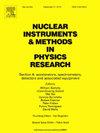嵌入Timepix4 ASIC作为像素化阳极的混合MCP-PMT的开发与表征
IF 1.4
3区 物理与天体物理
Q3 INSTRUMENTS & INSTRUMENTATION
Nuclear Instruments & Methods in Physics Research Section A-accelerators Spectrometers Detectors and Associated Equipment
Pub Date : 2025-08-22
DOI:10.1016/j.nima.2025.170965
引用次数: 0
摘要
我们提出了一种新型的单光子探测器,该探测器基于一个真空管,其中包含一个光电阴极,一个微通道板(MCP)和一个Timepix4 CMOS ASIC作为像素化阳极。该探测器设计用于在7cm2的有源区域内处理高达每秒10亿的光子速率,其空间和时间分辨率分别为5 - 10μm和低于50ps r.m.s。Timepix4 ASIC由大约23万个像素组成,每个像素都集成了模拟和数字前端电子设备。这使得数据驱动采集和支持数据传输速率高达160 Gb/s。外部基于fpga的电子管理配置和读出。为了测试Timepix4 ASIC的定时性能,我们使用脉冲红外激光对连接到100μm厚n-on-p硅传感器的组件进行了初步表征,其每像素定时分辨率为110ps,基于簇的平均方法提高到50ps以下。Hamamatsu Photonics公司制作了6个具有不同MCP堆叠结构和末端破坏深度的原型探测器。我们报告了它们的特性,包括暗计数率、增益、空间和时间分辨率,在实验室条件下和在CERN的SPS设施的测试光束运动中进行了评估。本文章由计算机程序翻译,如有差异,请以英文原文为准。
Development and characterization of hybrid MCP-PMT with embedded Timepix4 ASIC used as pixelated anode
We present a novel single-photon detector based on a vacuum tube incorporating a photocathode, a microchannel plate (MCP), and a Timepix4 CMOS ASIC functioning as a pixelated anode. Designed to handle photon rates up to 1 billion per second across a active area, the detector achieves outstanding spatial and temporal resolutions of and below r.m.s., respectively.
The Timepix4 ASIC comprises approximately 230,000 pixels, each integrating analog and digital front-end electronics. This enables data-driven acquisition and supports data transmission rates up to 160 Gb/s. External FPGA-based electronics manage both configuration and readout.
In order to test the timing performance of the Timepix4 ASIC we performed preliminary characterization of an assembly bonded to a thick n-on-p silicon sensor using a pulsed infrared laser, which demonstrated a per-pixel timing resolution of , with cluster-based averaging methods improving to below .
Six prototype detectors incorporating different MCP stack configurations and end-spoiling depths were produced by Hamamatsu Photonics. We report on their characterization, including dark count rates, gain, and spatial and timing resolutions, assessed both in laboratory conditions and during a test-beam campaign at CERN’s SPS facility.
求助全文
通过发布文献求助,成功后即可免费获取论文全文。
去求助
来源期刊
CiteScore
3.20
自引率
21.40%
发文量
787
审稿时长
1 months
期刊介绍:
Section A of Nuclear Instruments and Methods in Physics Research publishes papers on design, manufacturing and performance of scientific instruments with an emphasis on large scale facilities. This includes the development of particle accelerators, ion sources, beam transport systems and target arrangements as well as the use of secondary phenomena such as synchrotron radiation and free electron lasers. It also includes all types of instrumentation for the detection and spectrometry of radiations from high energy processes and nuclear decays, as well as instrumentation for experiments at nuclear reactors. Specialized electronics for nuclear and other types of spectrometry as well as computerization of measurements and control systems in this area also find their place in the A section.
Theoretical as well as experimental papers are accepted.

 求助内容:
求助内容: 应助结果提醒方式:
应助结果提醒方式:


